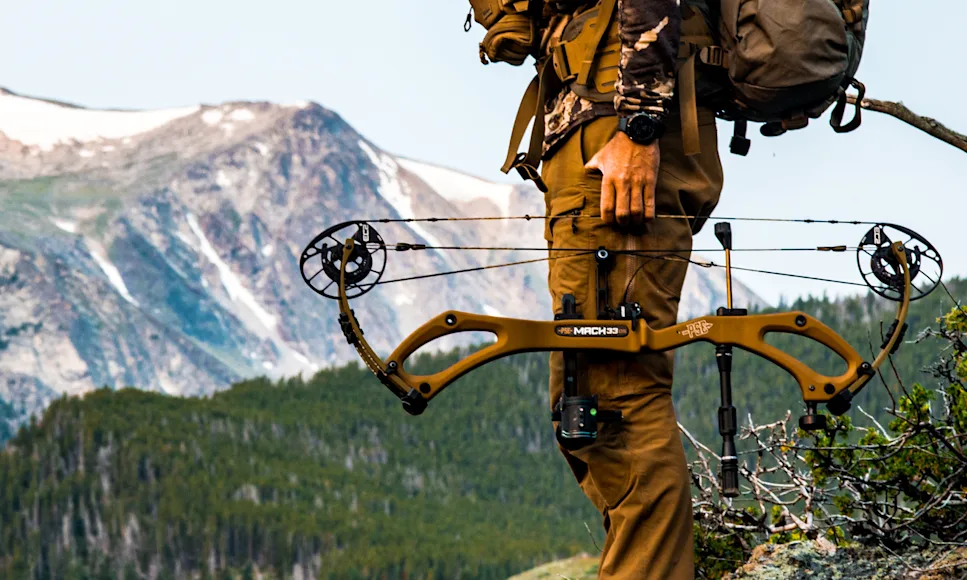PSE chased the speed bug for a long time, producing ultra-fast bows like the Omen and Omen Pro. But in recent years, the company has focused on creating innovative compounds that are still plenty fast enough yet are also smooth-drawing and accurate, with little to no post-shot noise or vibration.
All the while, the company has been refining their carbon-riser offerings, with the Carbon Air and Mach series. For 2025, all of this comes together with the new Mach 33 DS, which PSE says is "the most advanced hunting bow of its generation." That's big talk, so I was excited about putting the 33-inch, carbon-riser bow to the test to judge for myself. Here's my full review.
PSE Mach 33 DS Specs

Axle-to-Axle Length: 33"
Brace Height Length: 6-3/8"
Weight: 3 pounds, 9 ounces
Price: $1,899
Related: The Best Compound Bows of 2025, Tested and Reviewed
PSE Mach 33 DS Overview
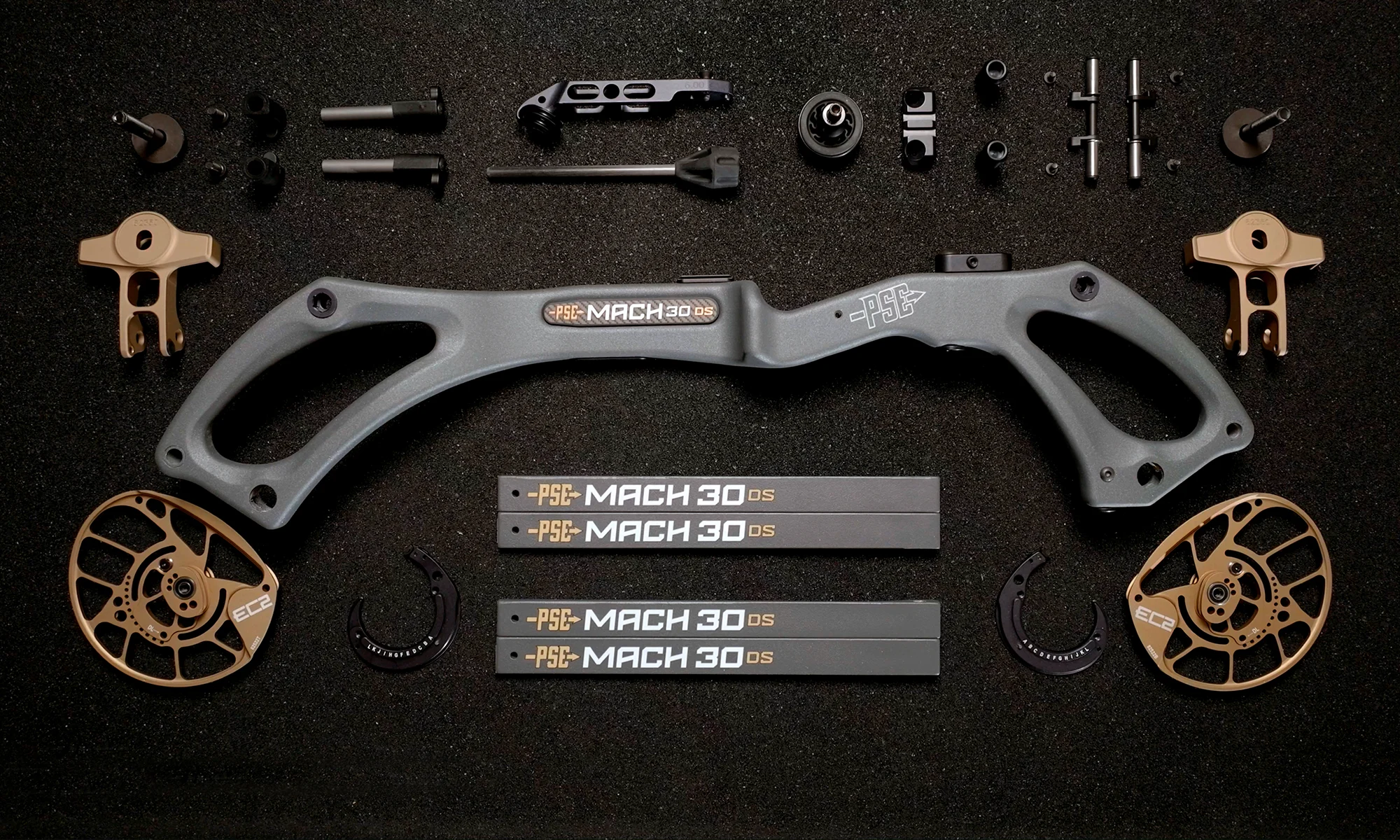
Compared to previous bows in the Mach series, the 33 DS's riser is a slimmed-down piece of carbon, and it has only two cutouts, above and below the limb pockets. PSE lists the bow's weight as 3.9 pounds, which is abnormally light for a bow with this much distance between the axle pins. But the instant you put this bow in your hands, you believe it. It feels like a feather.
The grip is direct-to-riser. PSE includes a single-threaded hole if you prefer an aftermarket grip, but I love the feel of carbon and wouldn't change a thing. The grip is skinny, perfectly angled, and flat-backed, which is just what I want. The riser transitions smoothly into the aluminum limb pockets, which PSE cut down to remove weight without compromising pocket strength.
The split-quad limbs are wide, thin, long, and have a dampener between them. PSE's EC2 Cam system is draw-length adjustable without a bow press from 25.5 and 31 inches. But the big news here for 2025 is the addition of the EZ.220 Snap Spacer tuning system, which eliminates the need to remove the axle pins to swap out spacers. The new Snap Spacers are easily removed and repositioned if the limb bolts are turned out four full turns and the bow is pressed. The spacers allow for cam shifts in .020-inch increments.
The axle system is also new to the EC2 Cam, which, according to PSE, prevents the overtightening of the axle screws. The carbon-rod string stop is located slightly below the stabilizer mounting hole, and the strings and cables looked good and rode smoothly in the cam grooves. Like many compound bow manufacturers, PSE put thought into accessory mounting. A machined dovetail plate on the back of the riser accepts IMS rests. The plate is removable for those wanting to access machined mounting holes. There's also a Picatinny rail on the front of the riser for sights with a PM (pic-mount) attachment system.
Related: Mathews Lift X Compound Bow Review
Mach 33 DS Bow Build
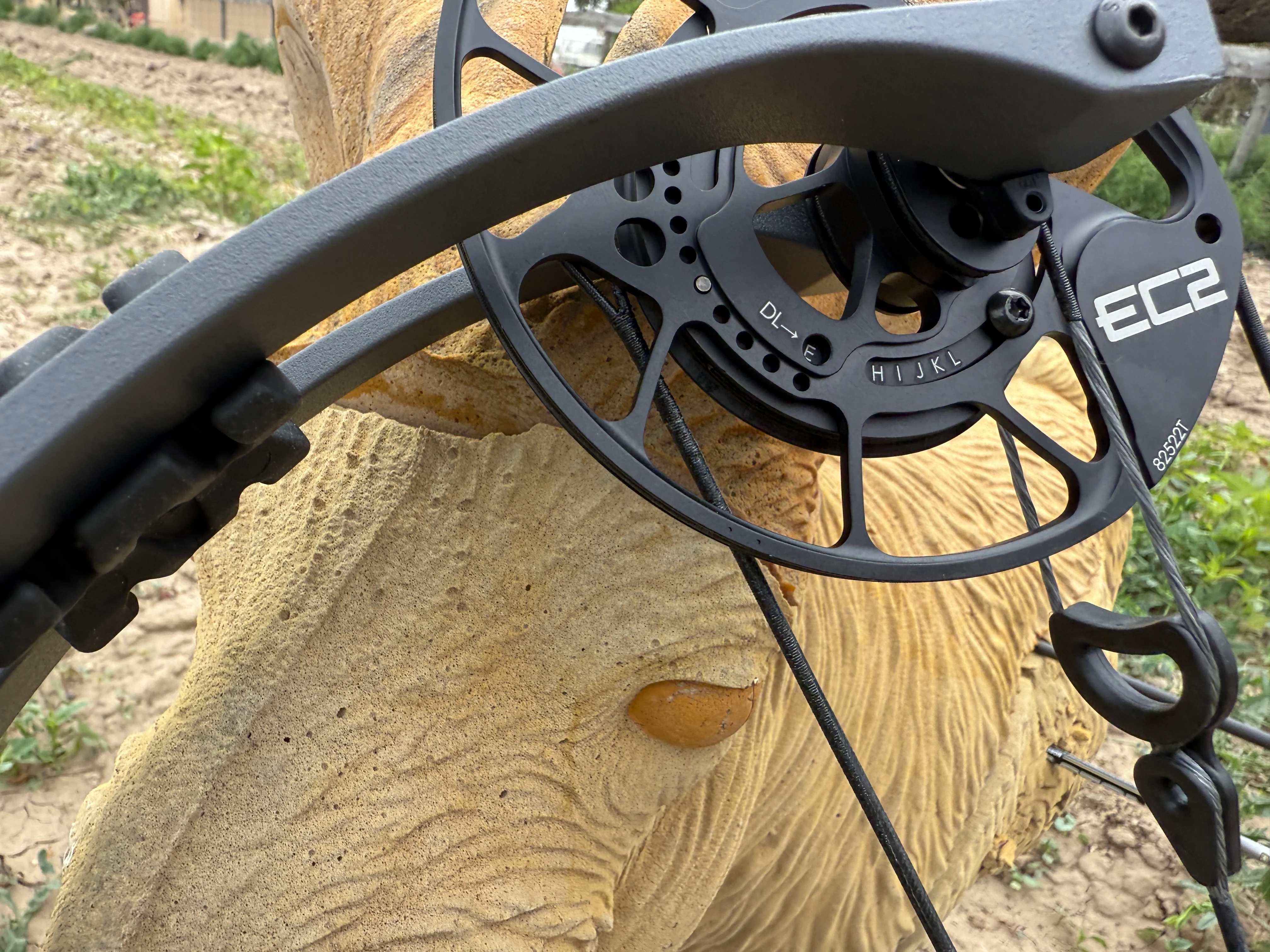
PSE requires the limb bolts to be turned out four complete revolutions before pressing. The limb bolts turned easily with no slop, pop, or chatter. After adding QAD's MX2 rest and inserting a peep, I maxed out the limb bolts and measured a weight of 70.02 pounds. All specs, including the 6-3/8-inch brace height, were as advertised.
Mounting Spot-Hogg's Boone 5-Pin PM sight to the two-slot Picatinny rail took seconds. PSE shipped the bow at a draw length of 29 inches, which was just right for me, but adjustments are easily made by following the PSE letter-system adjustment guide, loosening two module screws, and setting the correct letter in the DL (draw length) window on the top and bottom cam (see photo above). EC2 cams don't include a separate cable stop. Instead, rubber-padded cable stops are incorporated into the top and bottom modules. The removable stops have grooves for 80, 85, or 90 percent let-off adjustments. It's important to note that the bow's draw length would be 1/8-inch shorter in the 80 percent letoff than the 90 percent setting. Cam timing was perfect out of the box.
I set up Easton's all-new 5.0 arrows with four Flex-Flech Pro 2.5 vanes, 100-grain field points, HIT inserts, HIT collars, and 5mm Microlite nocks, with a total arrow weight of 381.5 grains. Then I was ready for the range.
Range Test Results
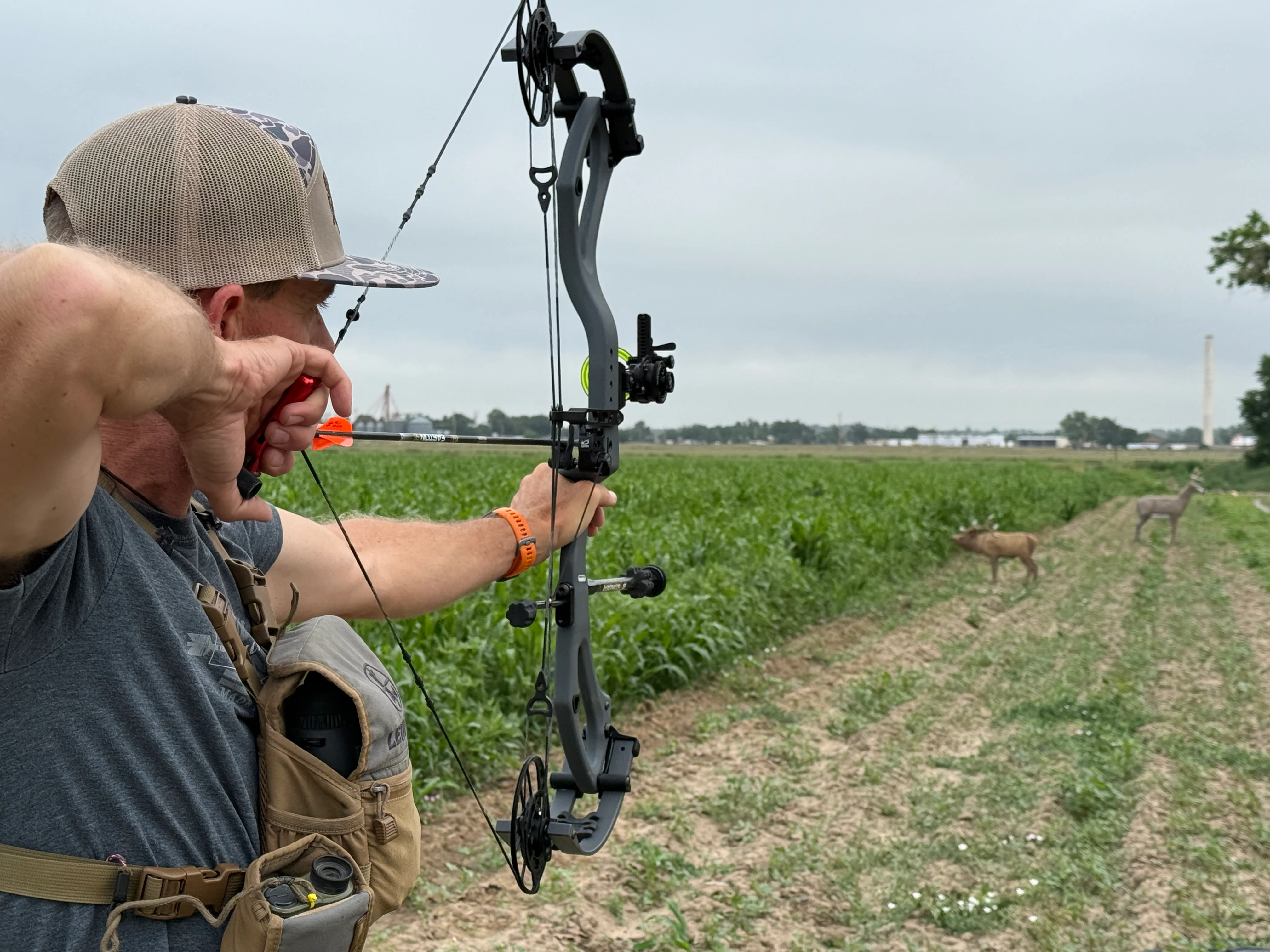
DS stands for Draw Length Stability. I mentioned the bow's extended brace height earlier, and it's critical to point out that PSE purposely increased the brace height to ensure maximum full-draw stability. The idea here is to reduce induced torque at full draw for better shot-to-shot consistency, and it did seem to prove itself on the range. The bow shot great at 20 and 40 yards. The draw cycle is remarkably smooth, and the transition into the bow's 80 percent let-off was nice. I could quickly crawl into my two-part anchor, acquire the target, and let the release fire the bow.
The long, stiff riser combined with PSE's Full Draw Stability system creates a rock-solid shooting platform that welds the pin to the target, reducing pin float and pre-shot anxiety. The valley is forgiving; the EC2 cams aren't itching to pull your shoulder through the riser like PSE speed demons of the past. I could pull the stops into the inner cable to create a small valley, promoting a great pre-shot feel.
The bow produces a slight thud at the shot, which is common for a bow with a carbon riser. As for hand vibration, there is none. PSE's Mach 33 DS is dead in the hand. This bow produces one of the finest shooting experiences in this year's tested flagship bows, and I found that it builds shooting confidence quickly.
The Mach 33 DS doesn't feel like a flamethrower, but it doesn't feel slow either. This was noticeable when I switched from shooting spots and dots to shooting 3-D targets on the range. My first group was from 55 yards with 100-grain field points on a fresh Rinehart Signature Jimmy BigTine 3-D target. Impact came quickly, and the 5.0 arrows sunk deep into the foam, a sign that the bow/arrow combo produced good kinetic energy. Throughout 100-plus arrows over several days, I shot foam and bag targets from 20 yards to 80 yards. Even with a slight nock-right travel, the PSE Mach 33 DS did its job if I did mine.
Mach 33 DS Final Tune
My first three shots through paper confirmed the nock-right tear, which was more aggressive than I thought. This is a testament to PSE's engineering. Even with the semi-poor tune, the bow shot exceptionally well. Pressing the bow and using the EZ.220 spacers was easy and intuitive. PSE provides a series of spacers and a tool that makes removal and insertion a breeze. Changing spacers allows you to shift the cam left and right. Cleaning up my right paper tear took seconds, and without moving my QAD MX2 rest, my first shot through paper after a spacer change was perfect.
I'm a stickler about tuning every arrow I plan to shoot on the range or use in the woods. It's common to get an arrow or two that don't tune with the rest of the shafts. This is usually remedied with a simple nock tune (rotate the nock 1/8-inch at a time). But there was no need in this case, all six arrows punched perfect holes in the paper after the spacer change.
Related: Hoyt RX-9 Ultra Compound Bow Review
Speed & Noise
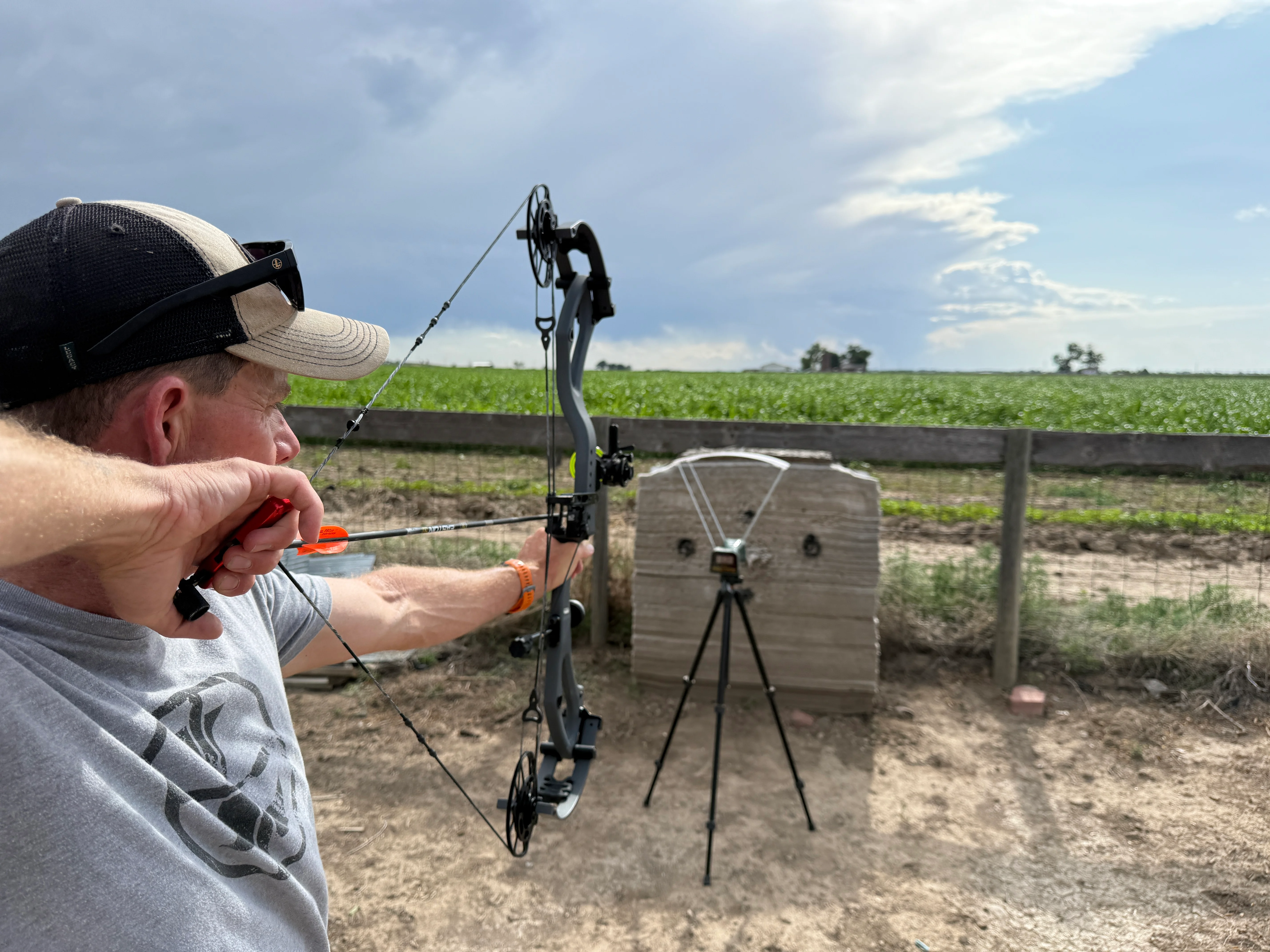
Set at a draw length of 29 inches and a draw weight of 70.02 pounds, PSE's Mach 33 DS produced a three-shot speed average of 309 fps. PSE deserves a pat on the back for this. While 309 isn't crazy speed, it's plenty fast, especially for a longer axle-to-axle bow with such a generous brace height. This bow is forgiving and provides some speed to cut through the wind, give some yardage error variance, and boost kinetic energy.
The lack of post-shot noise was equally as impressive. The slight thud I could hear turned out to be extremely subtle. The PSE Mach 33 DS produced a post-shot sound reading of 65.8 dB, which proved to be among the quieter bows tested this year.
Final Range Test
Cleaning up the paper tear made the bow even more accurate, of course. The day I shot my full 3-D range for a score; the wind blew 15 to 22 miles per hour from right to left. Still, I didn't shoot a single 5 or 8 on 24 targets with ranges between 13 and 55 yards. The more I shoot this carbon-riser bow, the more I liked it. Its length/weight ratio ensures a balanced hold, but it's not a tank to tote around the range. The 6-3/8-inch brace height boosts forgiveness, and the EC2 cams work with the entire system to provide solid speed. PSE's Mach 33 DS is an exceptional bow that every bowhunter needs to consider.
Final Thoughs on the PSE Mach 33 DS
Pros
Snap Spacers ensure easy tuning
Balanced at full draw and highly accurate
Quiet and dead-in-the-hand
Solid speed and great forgiveness
Cons
It's pricy
Turning the limb bolts out every time you need to press the bow.
As much as I liked the Mach 33 DS the more I shot it, I liked it even more when I shot it side-by-side with the other contenders in our annual bow test. So much so, that it ultimately won our Best Overall Compound Bow Award for 2025. The PSE, with its carbon riser, was the lightest in the test. Bowtech's Proven 34 was the only bow to beat it in the draw cycle category. The Mach 33 DS tied with the Hoyt RX-9 Ultra and Mathews Lift X 29.5 as the second most accurate bow, and, at 309 fps, it was the second-fastest bow. Bottom line: The Mach 33 DS checked all the boxes and deserved the win. If you're in the market for a new flagship bow for this fall's season, you need to go out and shoot the new Mach 33 DS.

